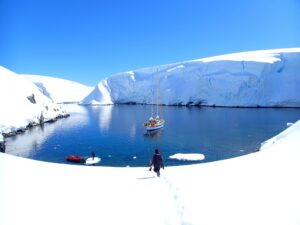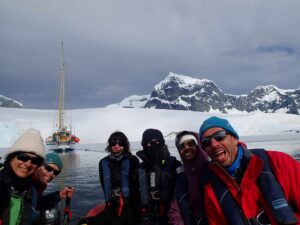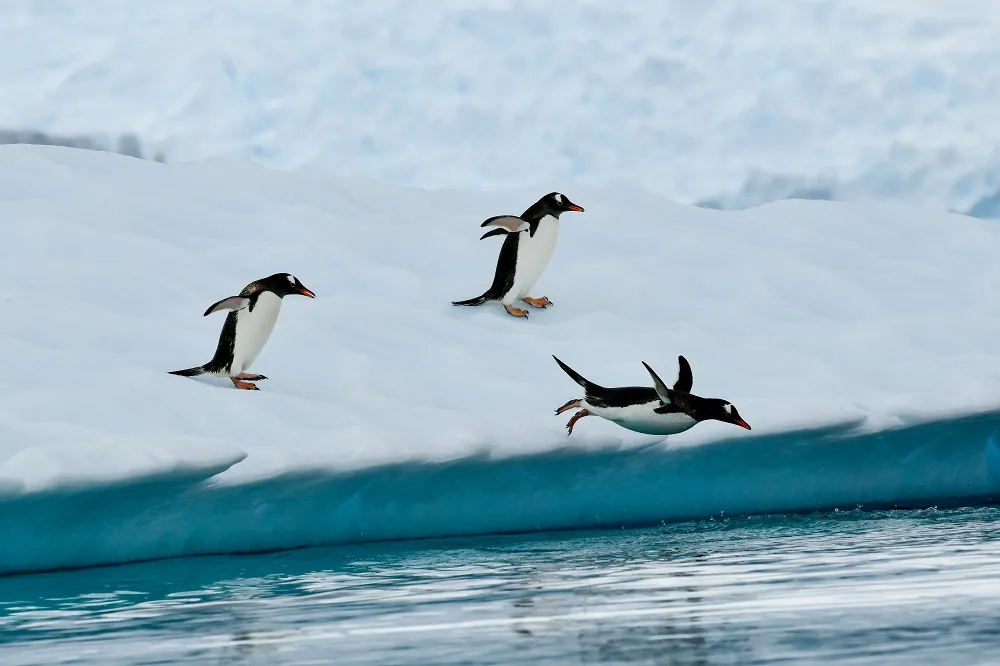Day 3-Quixote Expeditions Southern Oceans Passage
The day started with awakening in the night to whistling wind in the rigging, a less stable feeling berth and the sound of more anchor chain being paid out. The weather norm here is only that it is guaranteed to be different every few hours, with winds coming out of seemingly nowhere and cold rain pattering down. When the sun does peek out (and we have been very lucky these last few days) it feels like the whole world is smiling, there is still great warmth in this newly fall sun and the muted colors of the distant hills, cliffs and ocean become textured and alive.
After a coffee-filled breakfast we pulled up our anchor and motored a short distance, still within Bahia Aguirre, to visit the caves where missionary Alan Gardiner and 5 companions slowly starved to death. Along the same stretch of narrow, uninviting beach were the derelict remains of an abandoned 1950’s coast guard station. Once we reached the beach we clambered over slippery, mussel encrusted rocks to gain access to the cave. Reaching the cave at high tide would have involved wet feet and may have contributed to both the feeling of security but also isolation. The cave was deep enough to require a head torch to get a real look around. Along the cave walls was a mix of mold, crystals, Christ on the cross and a historical plaque. The dank smell of rotting seaweed and perpetually wet sand filled the humid and slightly sinister air. What desperate circumstances caused Alan and his group to choose this cave to set up residence? Did they just give up on life when they wrecked on the beach? These were questions I couldn’t help but think while re-entering the fresh air with new eyes for surviving this place. For shelter, the fairly short sandy and pebbly beach abutted a wall of trees ideal for construction and there was no shortage of drift wood along the beach and adjacent beaches. Freshwater poured down the hill and onto the beach, shellfish were clustered amongst the rocks, abundant kelp fastened to the low tide rocks and I even found a small fish washed up on the beach. Absolutely this is a harsh climate but not one completely devoid of food, but they starved to death once they finished the provisions they had brought with them from Europe. Walking along the beach I found bones of unknown origin (maybe from feral cows or horses) and small bits of green sea glass. The glass made me wonder further at the hidden histories of this remote beach.
With the sun shining we pulled up anchor and began our day long sail to Hoppner harbor, Isla de los Estados. As we sailed from the protection of the bay and surrounding hills, the wind and swell picked up. Soon we were either not moving about at all on the boat or if moving, doing so slowly, holding on the many handles around the boat and timing movements with the pitch and roll. The sea began to flatten out after a few hours and the looming piece of land of Isla de los Estados ahead of us began to take shape. Moving about became much easier and with the sun shining we found ourselves drawn to the bow of the boat and were rewarded by a pod of dolphins’ bow-riding.
I quickly realized that my previous notion of Isla de los Estados as a small island was quite incorrect. It is HUGE, long beaches, tall cliffs and treeless rugged mountains splitting the island in half, obscuring the end of the island from view. The shadows began to grow long and the shade from the sail drove the bow sitters inside briefly to warm up. We sailed about half the length of the island before turning in towards a hidden, bottle-necked harbor. Laura and I prepared the zodiac and were on standby to help if there were any problems as the 5.5-meter-wide boat squeezed through the 7-meter entrance. Ocean Tramp passed through without a hitch and we went deeper into the protected harbor to set straps on two trees. The anchorage is so narrow that in addition to dropping the hook we ran two lines off of the port and starboard stern of the boat to the trees to keep from swinging into land.
The trees are gnarled and the ground squishy with moss and other hardy plants underfoot. Steep hills covered in dense vegetation and large rocky mountains surround us. The water is dark with tannins but is clear enough to see the white shells dotting the bottom. Everyone is smiling with the enchantment of this little secluded spot where a waterfall cascades in the distance and our echo’s speak back to us, startling a few birds hopping in the trees. As the light fades, we go below deck to drink beers and snack while I give a presentation on global microplastic pollution as the follow up from yesterday’s presentation on my microplastic study goals and research during the expedition.
The sky is clear and a few stars are just beginning to show themselves. I will bundle up (and probably be joined by the rest of the folks) to do some gazing of the southern hemisphere stars while listening to the sound of the nearby stream. I am already looking forward to watching the sun rise on the peaks around us while I take a water sample to measure microplastic contamination tomorrow morning. I hope that this incredible island, which has defeated so many human attempts for settlement, is also free of our plastic pollution.
-Abby







